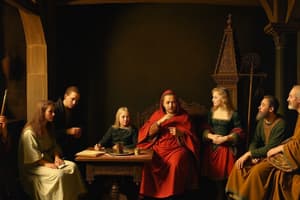Podcast
Questions and Answers
How was society structured in the Middle Ages?
How was society structured in the Middle Ages?
Medieval society was feudal, based on a rigid hierarchy and divided into three orders: the nobles, the clergy, and the peasants.
What does it mean that Medieval society was rigid?
What does it mean that Medieval society was rigid?
People believed that the three orders were established by God, and there was no way to change this social hierarchy.
Who were the nobles?
Who were the nobles?
The nobles were at the top of the social hierarchy, had titles and wealth, and fought in wars, including kings, dukes, earls, and knights.
What does it mean that the titles were hereditary?
What does it mean that the titles were hereditary?
What was the purpose of the right of primogeniture?
What was the purpose of the right of primogeniture?
Who was a vassal?
Who was a vassal?
Who were the clergy?
Who were the clergy?
Why did the clergy often overlap with the first order (the nobility)?
Why did the clergy often overlap with the first order (the nobility)?
What type of life did the clergy have?
What type of life did the clergy have?
Who were the peasants?
Who were the peasants?
How did the peasants live?
How did the peasants live?
When did things start to change in Medieval society?
When did things start to change in Medieval society?
Why did changes happen in Medieval society?
Why did changes happen in Medieval society?
What about the nobility during the changes?
What about the nobility during the changes?
Flashcards are hidden until you start studying
Study Notes
Structure of Medieval Society
- Medieval society was hierarchical and feudal, divided into three main orders: nobles, clergy, and peasants.
- Social mobility was virtually non-existent; the hierarchy was considered divinely ordained and unchangeable.
Nobility
- The nobility occupied the highest social ranks, including titles such as king, duke, earl, and knight.
- Their roles involved governance, land ownership, and military service.
- Titles and estates were hereditary, passed to the eldest son to maintain family wealth.
Right of Primogeniture
- The right of primogeniture ensured only the firstborn male inherited titles and estates, preventing family wealth from splitting among multiple heirs.
Vassalage
- Vassals were individuals who pledged loyalty to a lord in return for protection and land, committing to serve in military conflicts.
The Clergy
- Second only to the nobility, the clergy were dedicated church members who engaged in prayer and religious duties.
- Many clergy members originated from noble families, often due to the primogeniture system limiting inheritance options.
Clerical Privileges
- Although bound by vows of chastity and poverty, the clergy often possessed significant wealth and property, enjoying the privileges of their social position.
Peasantry
- Peasants formed the largest demographic, constituting about 90-95% of the population and lacking land ownership.
- They worked the land of lords and were bound to their estates, required to seek permission for personal decisions, such as marriage.
Life of Peasants
- Peasants relied on their lords for sustenance and protection, cultivating land in exchange for basic living conditions and security.
Social Changes in the 14th Century
- The onset of the Black Death in the 14th century drastically altered societal structures, leading to a decline in the population and weakening the rigid class system.
- As a result, peasants began to experience upward mobility as responsibilities shifted.
Economic Development
- The rise of towns became centers of trade and opportunity, prompting many lower-class individuals to migrate from rural to urban areas for better livelihoods.
- This transition facilitated a new merchant class that began to accumulate wealth.
Impact on the Nobility
- Many members of the nobility faced financial hardships, leading to strategic marriages with lower-class individuals for survival.
- The emergence of the middle class marked a significant shift in social dynamics and economic power within society.
Studying That Suits You
Use AI to generate personalized quizzes and flashcards to suit your learning preferences.




